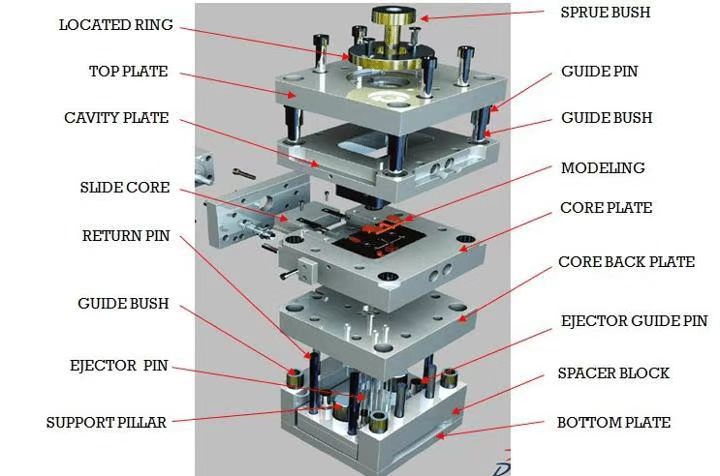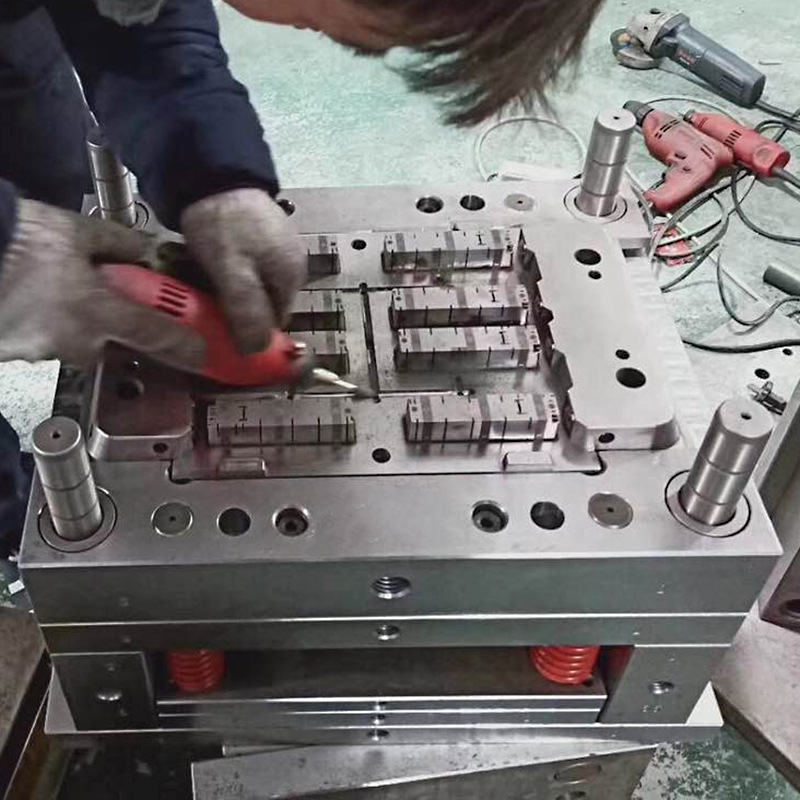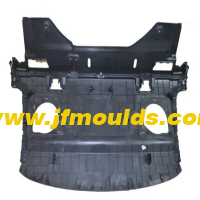In-depth Analysis of the Injection Mold Industry
In-depth Analysis of the Injection Mold Industry
I. Overview of the Injection Mold Industry
(1) Definition and Function of Injection Molds
Injection molds are tools used for plastic molding. They inject molten plastic into a mold cavity of a specific shape, and after cooling and solidification, they form plastic products of the desired shape. Injection molds play a crucial role in the production process of plastic products. They determine the shape, size, precision and surface quality of plastic products and are widely used in numerous industries such as automobiles, home appliances, electronics, packaging and medical care. They are an indispensable key link in modern manufacturing.
(2) Classification and Structure of Injection Molds
Injection molds can be classified into various types based on different criteria. Common ones include single parting face injection molds, double parting face injection molds, hot runner injection molds, and gas-assisted injection molds, etc. Its basic structure is usually composed of forming components, gating system, guiding components, demolding mechanism, temperature regulation system and exhaust system, etc. Each part has its specific function and works in coordination to ensure the smooth progress of the injection molding process.
Ii. Current Market Situation of Injection Mold Industry
(1) Global market size and Growth trends
In recent years, the global injection mold market has shown a steady growth trend. According to data from market research institutions, the global injection mold market size has continued to expand in the past few years and is expected to maintain a certain growth rate in the coming years. This is mainly attributed to the recovery and development of the global manufacturing industry, especially the increasing demand for plastic products in industries such as automobiles and electronics.
(2) The Position and Development Characteristics of the Chinese Market
As a significant global manufacturing base, China also holds a pivotal position in the injection mold industry. The market size of injection molds in China is huge and growing at a relatively fast rate. On the one hand, the vigorous development of domestic manufacturing has provided a vast market space for the injection mold industry; On the other hand, Chinese injection mold enterprises have been continuously improving in terms of technological level, product quality and production efficiency, gradually making their mark in the international market. Meanwhile, the Chinese injection mold market also shows the characteristic of unbalanced regional development, mainly concentrated in manufacturing developed regions such as Guangdong, Jiangsu and Zhejiang.

(3) Market Demand Analysis
Industry demand:
The demand for injection molds in the automotive industry is mainly reflected in the production of plastic products such as automotive interiors, exteriors, and engine parts. With the development trend of automotive lightweighting and intelligence, higher requirements have been put forward for the precision and complexity of injection molds. The home appliance industry requires a large number of injection molds to produce various home appliance shells and internal components. The diverse demands of consumers for the appearance and functions of home appliances have driven the innovative development of injection molds. The demand for injection molds in the electronics industry is mainly focused on the manufacturing of shells and components for electronic products such as mobile phones, computers, and tablets. With the accelerated pace of product updates and replacements, the production cycle and quality requirements for injection molds are also getting higher and higher.
Bumper Mould Manufacturer in China (jfmoulds.com)
2.Product Requirements:
High-precision injection molds can produce plastic products with higher dimensional accuracy and better surface quality, meeting the manufacturing demands of high-end products. They are widely used in fields such as aerospace and medical devices. Large injection molds are mainly used for manufacturing large plastic products, such as car bumpers and industrial containers. With the increasing market demand for large plastic products, the market prospects for large injection molds are also quite broad. Complex-structured injection molds can produce plastic products with complex shapes and internal structures, such as the irregular design of mobile phone casings and the complex inner cavities of automotive engine intake manifolds. Their technical difficulty is relatively high, and the market demand is also gradually increasing.
(4) Market Supply Analysis
1. Number and scale distribution of enterprises:
At present, there are a large number of injection mold enterprises worldwide, with varying scales. In terms of enterprise scale, there are both large multinational mold enterprises and numerous small and medium-sized mold enterprises. Large enterprises usually possess advanced technical equipment, strong R&D capabilities and a complete service system, and occupy a dominant position in the high-end market. Small and medium-sized enterprises play a significant role in the mid-to-low-end market by virtue of their flexibility and cost advantages. In China, the number of injection mold enterprises is also quite large, among which those in Guangdong, Jiangsu and other places are the most concentrated. Among these enterprises, there are not only large-scale listed companies such as Haitian Plastic Machinery Group and Chung Hsing Group, but also a large number of small and medium-sized private enterprises.
2. Technical level and production capacity:
With the continuous advancement of technology, the technical level of the injection mold industry is also constantly improving. At present, advanced injection mold manufacturing technologies include high-speed milling, electrical discharge machining, five-axis linkage machining, 3D printing, etc. The application of these technologies has significantly improved the manufacturing accuracy, production efficiency and quality of injection molds. Meanwhile, some enterprises have also introduced intelligent production management systems, achieving the automation and informatization of the production process, and further enhancing production capacity and management level. However, there are still considerable disparities in technological levels and production capabilities among different enterprises. Some small and medium-sized enterprises still encounter certain difficulties in technological innovation and equipment renewal.
Iii. Technological Development in the Injection Mold Industry
(1) Traditional injection mold manufacturing technology
1. Mechanical processing technology
Turning is mainly used for processing the rotating parts of injection molds, such as cores and ejector pins. Through the rotation of the lathe and the feed motion of the tool, the workpiece is processed into the required shape and size. Milling can be used to process the planes, curved surfaces and cavities of molds, etc. Commonly used milling equipment includes CNC milling machines and machining centers, which can achieve high-precision milling processing. Grinding processing is used to improve the surface finish and dimensional accuracy of mold parts and is usually carried out after mechanical processing, such as surface grinding, cylindrical grinding, internal grinding, etc.
2. Electrical Discharge Machining technology
Electrical discharge forming (EDM) is a process that uses the high temperature generated by discharge to corrode metals, thereby machining the required shape and size on mold workpieces. It is particularly suitable for processing complex-shaped cavities and parts that are difficult to machine mechanically. Electrical discharge wire cutting (EDM) processing uses a moving fine metal wire as an electrode to perform pulsed discharge corrosion cutting on the workpiece. It is often used to process irregular holes and narrow slots in molds.

(2) Advanced injection mold manufacturing technology
1. Application of 3D Printing Technology in Injection Mold Manufacturing
3D printing technology, also known as additive manufacturing technology, has unique advantages in injection mold manufacturing. It can quickly produce prototypes of molds for verification and optimization of product design, significantly shortening the mold development cycle. It is capable of manufacturing complex-structured molds that are difficult to achieve through traditional processing methods, such as conformal cooling water channel molds, thereby enhancing the cooling efficiency of the molds and the quality of injection molding. It can also achieve personalized customized production to meet the special needs of different customers. At present, the application scope of 3D printing technology in injection mold manufacturing is constantly expanding, and certain progress has been made from the production of small mold components to the printing of entire molds.
2. Development and Application of Hot Runner Technology
Hot runner technology is a process in injection molding that uses a heating device to keep the plastic in the runner in a molten state all the time, avoiding the formation of solidified material in the cold runner system, thereby improving the injection molding efficiency and product quality. With the continuous development of hot runner technology, its application is becoming increasingly widespread. The types of hot runner systems are also increasingly diverse, including open hot runners and needle valve hot runners, which can meet the injection molding requirements of different plastic products. Meanwhile, hot runner technology has also made remarkable progress in temperature control, runner design and system stability.
3. The Penetration of intelligent Manufacturing Technology in the Injection Mold Industry
Intelligent manufacturing technology is an important direction for the future development of the injection mold industry. By introducing technologies such as sensors, the Internet of Things, big data, and artificial intelligence, intelligent monitoring and management of the injection mold production process can be achieved. For instance, sensors are used to monitor parameters such as the temperature, pressure and vibration of the mold in real time. Through data analysis, potential faults of the mold can be detected promptly and early warnings can be issued. Optimize the injection molding process parameters by leveraging artificial intelligence algorithms to enhance the molding quality and production efficiency of products. Automated equipment and robots are adopted to carry out operations such as loading, unloading, handling and processing of molds, reducing manual intervention and enhancing the accuracy and stability of production.
(3) Innovation and Development of Injection Mold Materials
1. Research and Application of New die Steel
To meet the requirements of injection molds for high strength, high hardness, high wear resistance and good processing performance, new types of mold steel are constantly emerging. For instance, some high-performance die steels, based on traditional die steels, have enhanced the comprehensive performance of die steels by optimizing alloy composition and heat treatment processes. Meanwhile, in response to different application scenarios of injection molds, mold steels with special properties have been developed, such as corrosion-resistant mold steels and hot work mold steels, further expanding the application scope of mold steels.
2. Application Expansion of High-Performance Plastic Materials in Injection Molds:
In addition to die steel, the application of high-performance plastic materials in injection molds is also receiving increasing attention. Some plastic materials with high strength, high heat resistance and high corrosion resistance, such as polyetheretherketone (PEEK) and polyphenylene sulfide (PPS), can be used to manufacture components of injection molds, reducing the weight of the molds and improving their insulation performance and chemical stability. In addition, the molding process of plastic materials is constantly being improved to better meet the requirements of injection mold manufacturing.
Iv. Application Fields of Injection Mold Industry
(1) The automotive industry
1.The demand characteristics of injection molds for automotive parts:
The automotive industry is one of the important application fields of injection molds, and the demand for injection molds is characterized by high precision, high complexity and mass production. There are numerous types of automotive parts, including interior parts (such as instrument panels, seats, door trim panels, etc.), exterior parts (such as bumpers, lamp covers, rearview mirror housings, etc.) and engine parts (such as intake manifolds, oil pans, etc.). These parts vary in shape and size, and thus have extremely high requirements for the design and manufacture of injection molds. Meanwhile, to meet the requirements of high efficiency and low cost in automotive production, injection molds need to have good durability and production stability, and be capable of achieving large-scale production.
2.Typical Case Analysis
Take a certain automobile manufacturing enterprise as an example. When it produced the bumpers of new models of cars, it adopted a set of high-precision injection molds. This mold adopts hot runner technology and gas-assisted injection molding process, which not only improves the forming quality of bumpers, reduces product defects, but also shortens the injection molding cycle and enhances production efficiency. In addition, the design of the mold fully takes into account the structural features and appearance requirements of the bumper. By optimizing the parting surface and cooling system of the mold, the dimensional accuracy and surface finish of the bumper are ensured, meeting the strict quality requirements of automotive enterprises for products.
(2)Home appliance Industry
1.The degree of reliance of household appliances on injection molds:
The home appliance industry is highly dependent on injection molds. Almost all the shells and internal components of home appliances need to be produced through injection molds. With the continuous development of the home appliance industry and the increasing demands of consumers for the appearance and functionality of home appliances, injection molds are playing an increasingly important role in ensuring the quality of home appliances, reducing production costs and achieving product innovation.
2. Innovative Applications of Injection Molds in the Home Appliance Industry
To meet the diverse and personalized demands of household appliances, injection molds are constantly being innovatively applied in the household appliance industry. For instance, the use of two-color injection molds enables the one-time injection molding of plastic products of two different colors or materials, offering more possibilities for the appearance design of household appliances. The thin-walled injection molding technology can be used to produce thinner and lighter home appliance shells, which not only saves material costs but also enhances the aesthetic appeal and heat dissipation performance of the products. In addition, some home appliance enterprises have also collaborated with mold manufacturers to develop injection molds with special functions, such as antibacterial injection molds and self-cleaning injection molds, endowing home appliances with new features and selling points.
Two Color Mould_Taizhou Jiefeng Mould Co.,Ltd. (jfmoulds.com)
(3)Electronics industry
1. Application scenarios of injection molds in electronic equipment manufacturing:
In the field of electronic equipment manufacturing, injection molds are widely used in the production of casings, components and internal structural parts of various electronic products such as mobile phones, computers, tablets and headphones. With the rapid development of electronic technology, electronic products are moving towards miniaturization, thinness and multi-functionality, which puts forward higher requirements for the precision, dimensional stability and production efficiency of injection molds.
2. Mold solutions for the rapid upgrading of electronic products:
In order to meet the market demand for rapid updates and replacements of electronic products, injection mold enterprises need to constantly enhance their R&D capabilities and rapid response capabilities. On the one hand, by adopting advanced mold design software and manufacturing technologies, the development cycle of molds can be shortened; On the other hand, establishing a flexible production management system enables rapid adjustment of production plans to meet the small-batch and multi-variety order demands of different customers. In addition, some mold enterprises have established long-term strategic cooperative relationships with electronic equipment manufacturers, getting involved in the research and development and design stage of products in advance, and providing mold technical support for the innovation of electronic products.
Related News
Solutions for burrs, sticking to the mold, wire clamping and deformation of the mold
2025-09-01
Solutions for burrs, sticking to the mold, wire clamping and deformation of the ...
Mold exhaust (2)
2025-10-16
Mold exhaust (2)One: Insert exhaustIn the thin-walled structure cavity, the end ...
Treatment methods for mold weld marks/shrinkage marks and fractures
2025-08-09
Treatment methods for mold weld marks/shrinkage marks and fracturesMold weld mar...
The innovative design and intelligent development trend of injection molds
2025-07-09
The innovative design and intelligent development trend of injection molds In...
The lateral core-pulling mechanism of
2025-10-19
The lateral core-pulling mechanism of "slider inclined guide column"I. Classific...
How can the top white and surface elevation of the mold be solved
2025-08-26
How can the top white and surface elevation of the mold be solvedThe top white o...





